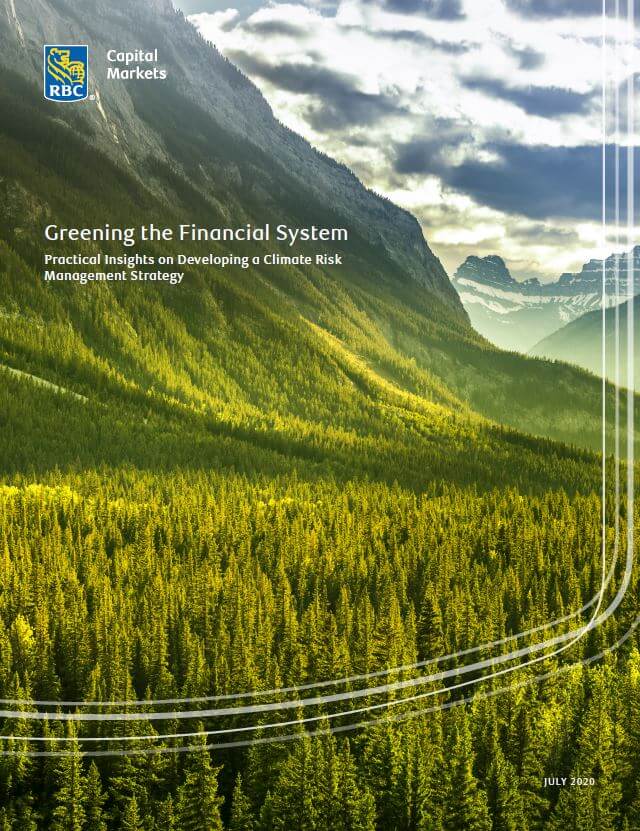Climate change will be a dominant theme in the coming decades that will influence public policy to support technologies, practices, and companies that are less carbon intensive. While the impact of the COVID-19 pandemic continues to be felt globally, climate change issues remain on the agenda of governments.
The need for urgent and decisive action to slow down the impact of climate change is clear, however, the path forward is uncertain because of the sheer size, complexity and scope of the challenge. At the same time, there is cause for optimism as many Canadian companies have emerged as leaders in developing and implementing ambitious policies on reducing carbon emissions. A balanced approach is required to address the pressing issue and also maintain a fair and a level global playing field for natural resources industries in Canada.
In a recently published RBC Capital Markets report, we provide an overview of regulators’ approaches to mitigate climate change risk and “green” the financial system. It provides practical guidance on developing a climate risk management strategy. The transition to a low-carbon economy and green financial system will create tremendous opportunities for companies that are ready, able and willing to seize them.
Here are five key takeaways from the Greening the Financial System Report:
1.Climate change poses physical and transition risks
The climate change risks fall into two broad categories: physical and transition risks. Physical risks come from more frequent and severe weather events that cause financial loss due to damage to property and infrastructure, disruption to transportation and trade and lower economic productivity.
Transition risks emerge from changes in technology, markets, regulatory frameworks and public sentiment as the world moves to a lower-carbon economy. These changes may negatively impact the viability of carbon-intensive assets and activities.
2.Public-Private collaboration will position Canada for success in a low-carbon economy
Central banks and prudential regulators view climate change as a growing risk to financial stability and believe that intervention may be required from central bankers to mobilize the financial system to support the transition toward a sustainable economy.
Market conduct regulators have taken action to improve investor protection and market fairness in the emerging markets for sustainable finance and Environmental, Social and Governance (ESG) financial products. The market for such products is estimated to be worth between US$30-80 trillion.
Canada is uniquely positioned with a diversified, and a resource-rich economy; a world-leading financial sector; and a demonstrated capacity for innovation, to become a global market leader in developing the vision and pathway for clean innovation in natural resources led by a close collaboration between the public and the private sector and smart regulation.
3.Assess exposure to climate change risks
Companies should evaluate and understand their exposure to the physical and transition risks of climate change. This involves building in-house expertise to make these evaluations and respond to stakeholder inquiries on climate-related risks in their businesses. Managing climate risks should be built into the fabric of a firm’s corporate governance with accountability to the board and senior executives.
As regulators integrate physical and transition risks into their financial stability monitoring and supervision of banks, banks will be required to understand climate risks in their own portfolio. There could be higher costs for banks to intermediate financial services for clients in carbon-intensive firms that do not take steps to manage their climate-related impacts.
4.Voluntarily disclose climate-related financial information
Climate-related data is being collected on firms by regulators, rating agencies, investors, creditors and counterparties to make evaluations about companies, their products and operations. Disclosing climate-related risks and opportunities, and ESG performance more broadly, will enable companies to take control of their sustainability narrative. Central banks and regulators are pushing for comprehensive climate disclosures to bring climate risk and resilience into the heart of financial decision making and to ensure that the market has the right information to price climate risk and reward climate innovation.
Disclosures should be in accordance with market standards and frameworks, most notably those set by the Task Force on Climate Related Disclosures (TCFD) and Sustainability Accounting Standards Board (SASB).
5.Adapt. Develop. Succeed.
As ESG principles are incorporated into the portfolio management practices of central banks, there could be a shift in the allocation of capital towards firms that perform highly on ESG metrics, which presents a significant economic opportunity. In addition, the global market for low-carbon solutions is estimated to be worth USD $26 trillion and create 65 million jobs by 2030. Global investment in climate-resilient infrastructure is estimated to be US$90 trillion over the next 15 years.
